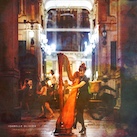

Isabelle Olivier: Impressions
Rewound Echoes
In titling her latest recording after John Coltrane's “Impressions,” one might reasonably expect harpist Isabelle Olivier to have delivered a novel take on modal jazz or even perhaps a Coltrane homage. Yet while she did draw for inspiration from the tenor sax legend and does conclude her same-titled album with a treatment of his composition, Impressions more explores the connections between Impressionism as a visual art form and jazz-and-classical musical hybrids. To tackle a project so ambitious, Olivier assembled an electro-acoustic ensemble of equivalent scope comprising a string quartet (violinists Mathias Naon and Anne Le Pape, violist Cyprien Busolini, cellist Jean-Philippe Feiss), drummer Baptiste Thiebault, pianist-accordionist Tom Olivier-Beuf, and electronic musician Raphael Olivier for the sessions (the latter two, interestingly, are also her sons).
Issued on her own Rewound Echoes imprint, the release is the latest in a long string of unconventional artistic moves by the adventurous harpist. Rather than staying in one lane, she's regularly forged connections between genres usually held apart and sought out collaborations that would enrich and advance her artistic practice. Indicative of her open-minded sensibility, her 2021 album Smile paid homage to, as expected, Charlie Chaplin but also Emily Dickinson, Cannonball Adderley, and James Blake. Olivier's someone, in other words, who welcomes and embraces the cross-pollination that results when genre boundaries are blurred.
She has a home in in France, and thus the connection to French culture comes naturally and as naturally amplifies the painterly dimension of her music. The rich hues and textures so fundamental to Impressionism find their counterpart in the elegantly layered pieces the harpist crafted for the album. While she arranged and composed some of the album material as meticulously as a Seurat painting, Olivier encouraged an entirely other dynamic to emerge by offsetting those formal creations with a number of brief group improvisations. In these cases, contrasting moods and ideas are collectively explored, the results often arresting for being so unpredictable. These vignettes aren't as satisfying compositionally as the others and momentum sometimes slows when they arise, but they do enhance the recording in adding experimental exploration to the mix.
Many pieces were inspired by European artists, from Van Gogh and Cezanne to Bartók and Ravel, but others reflect Olivier's ties to the United States and the other place she calls home, Chicago. The high-energy “Bike” is named after a piece by Chicago-based illustrator Darcy Day Zoell, while another, “The Boating Party,” is based on a painting by the American Impressionist Mary Cassatt. Connections to both locales are established via “La Gare,” which alludes to both Claude Monet's “Arrival of the Normandy Train, Gare Saint-Lazare” and its Art Institute of Chicago home.
A side-long reference to Van Gogh's “Sunflowers” paintings is made in the opening track, “Fleurs de Soleil,” written by Olivier in tribute to her elderly mother. The peaceful tone of its meditative intro morphs into a lilting swirl of small-group splendour, with Olivier sprinkling harp flourishes across a painterly backdrop of piano, strings, and brushed drums that straddles jazz and classical like it's the most natural thing in the world. Drawing upon the musicological explorations of Bartók, “Eclats” draws the music into an Eastern European folk realm when Olivier-Beuf's accordion chugs alongside the radiant shimmer of the leader's instrument. Partnering with strings, drums, and harp, his accordion points the music in a South American direction for “The Boating Party” before taking the full plunge in the romantic, Piazzolla-flavoured “Tango.”
Electronics are used judiciously and subtly woven into the arrangements. On “An Open Window,” an evocation of Olivier's visit to an island on Lake Michigan, the treatments Raphael applies to her harp produce atmospheric flutter and ripple effects that effectively conjure the hazy allure of the setting. It's interesting to hear how boldly Olivier and company recast Ravel's familiar “Forlane” as a rhythmically vibrant jazz-classical expression. She's not averse to playful pairings either, as shown when she follows the train-themed “La Gare” with Trane's breezily propulsive title track. As central as Olivier's harp is to these arrangements, Impressions is nevertheless more an ensemble statement than one featuring a soloist and backup musicians. There's much to recommend about the release, from Olivier's writing to the luscious sound worlds generated by the ensemble. First and foremost, however, is the leader's harp playing, which is never less than authoritative and assured.April 2025